Updated news: See my new blog post about the launch here
The Lunar Codex, a monumental multimedia archive, is a captivating time capsule of contemporary art, poetry, music, films, and literature from creators hailing from 157 countries. This remarkable project aims to preserve the essence of human creativity and cultural expression.
I am excited to share that The New York Times recently released a fascinating article about the Lunar Codex, shedding light on its significance and the creative brilliance it encapsulates. I invite you to read all about this unprecedented project and immerse yourself in the profound impact it will have on the art world and beyond.
The Lunar Codex, an archive of contemporary art, poetry and other cultural artifacts of life on Earth, is headed to the moon.
Read more about my contribution to this awesome project here in my blog post entitled: My Art on the Moon … Really?
Here is the New York Times article in full
Article by J. D. Biersdorfer, New York Times – July 27, 2023
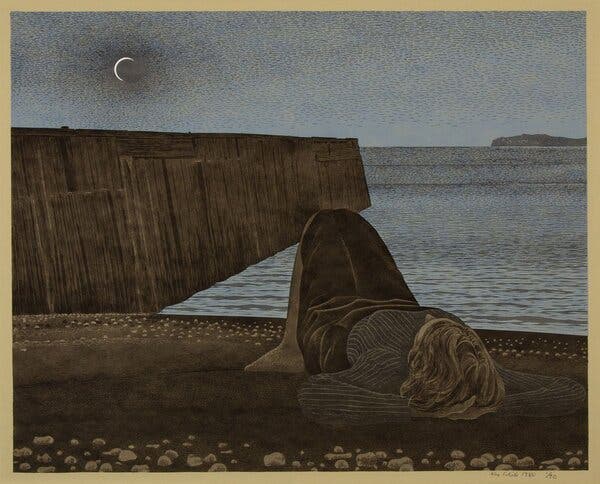
A digital copy of “New Moon,” a 1980 color serigraph by the Canadian artist Alex Colville, is included in the Lunar Codex.
Credit…Estate of Alex Colville; via Mira Godard Gallery
“Just keep telling the story,” says the director character in Wes Anderson’s latest film, “Asteroid City,” which takes a stylized look at midcentury America’s fascination with space and interstellar communications. Later this year, the Lunar Codex — a vast multimedia archive telling a story of the world’s people through creative arts — will start heading for permanent installation on the moon aboard a series of unmanned rockets.
The Lunar Codex is a digitized (or miniaturized) collection of contemporary art, poetry, magazines, music, film, podcasts and books by 30,000 artists, writers, musicians and filmmakers in 157 countries. It’s the brainchild of Samuel Peralta, a semiretired physicist and author in Canada with a love of the arts and sciences.
Prints from war-torn Ukraine and poetry from countries threatened by climate change are in the Codex, as well as more than 130 issues of PoetsArtists magazine. Among the thousands of images are “New American Gothic,” by Ayana Ross, the winner of the 2021 Bennett Prize for women artists; “Emerald Girl,” a portrait in Lego bricks by Pauline Aubey; and the aptly titled “New Moon,” a 1980 serigraph by Alex Colville. Some works were commissioned for the project, including “The Polaris Trilogy: Poems for the Moon,” a collection of poetry from every continent, including Antarctica.
An art collector and poet himself, Peralta, the executive chairman of the Toronto-based media and technology company Incandence, has been reaching out to creators through gallery and publishing connections to select the works (and get archival permissions) for free inclusion in the Codex. He has also accepted works submitted by individual artists.
“This is the largest, most global project to launch cultural works into space,” Peralta said in an interview. “There isn’t anything like this anywhere.”

A painted portrait of a Black couple standing in front of a white clapboard house with a stained-glass window on the top floor. The Lunar Codex also includes a digital copy of “New American Gothic,” a 2019 painting by Ayana Ross, who won the 2021 Bennett Prize for women artists. Credit…The Bennett Prize
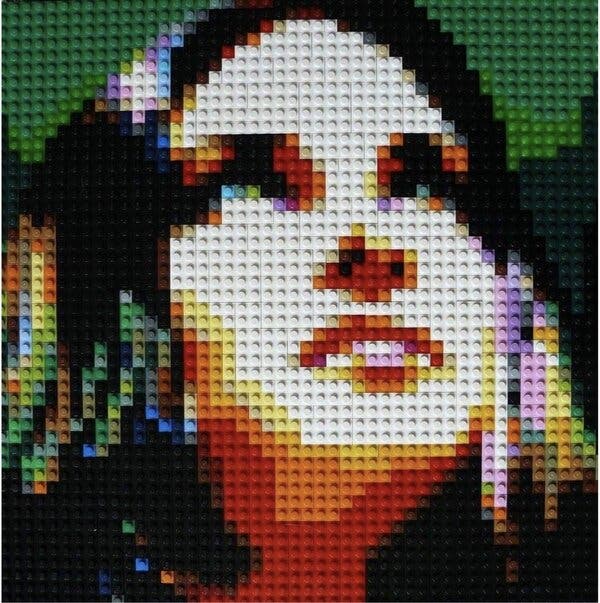
A colorful portrait, created in tiny plastic Lego bricks, showing a young woman’s face as she gazes upward.
An image of Pauline Aubey’s 2017 portrait “Emerald Girl,” which was created in Lego bricks. Credit…via 33 Contemporary GalleryInsert your content here
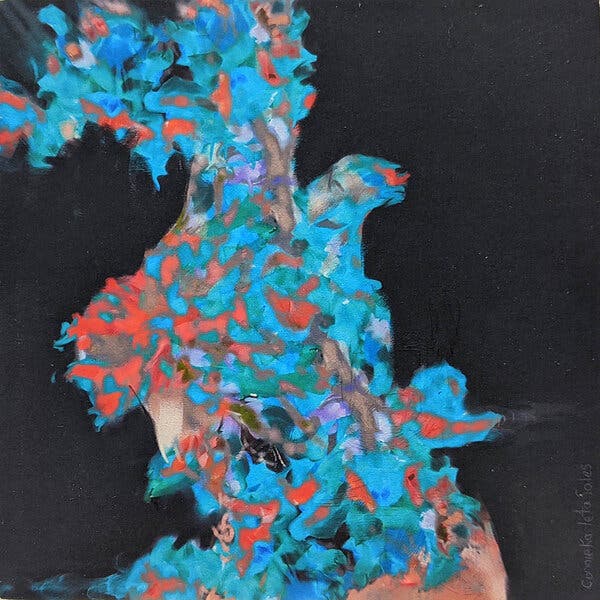
A swash of bright blue, red, brown and purple paint swashes against a black background.
“Electric Joy,” a painting by Connie Karleta Sales, was created using digital eye gaze technology. Credit…via 33 Contemporary Gallery
The Codex represents creators from a range of experiences. It includes several pieces from Connie Karleta Sales, an artist with the autoimmune disease neuromyelitis optica, who makes paintings using eye-gaze technology. “Electric Joy,” one of the works, “celebrates the color and movement of my mind,” Sales said in an email. “I might have limited use of my physical body, but my mind is limitless. It is dancing, laughing, crying and loving.”
Olesya Dzhurayeva, a Ukrainian printmaker, had evacuated Kyiv in April 2022 in the first months of the Russian attack when Peralta, who had previously purchased some of her work, contacted her with a supportive message. He also asked for her permission to archive images of several of her linocuts in the Lunar Codex, and she agreed. “This project is so life-affirming with thoughts about the future,” she wrote in an email. “This is exactly what I needed in those first months.” A collection of her pieces are represented in the Codex, including a series of woodcuts printed with black Ukrainian soil.
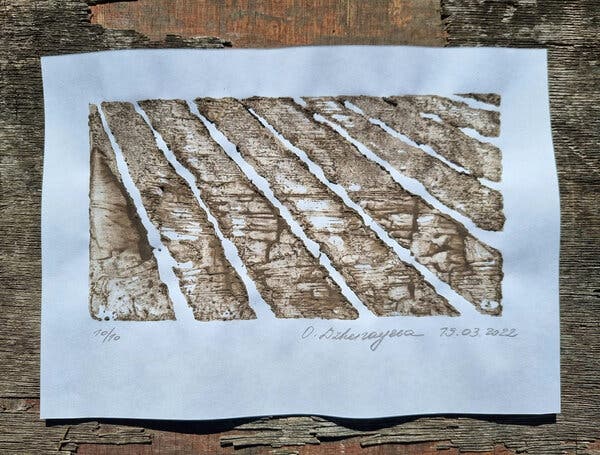
A textured piece of paper printed with brown soil and depicting an image of a plowed field. The artist’s name is signed underneath. As war came to her country in 2022 and she had to leave Kyiv, Olesya Dzhurayeva created a series of woodcuts printed in dark Ukrainian soil, including “We Stand on Our Own Land.” Credit…via Olesya Dzhurayeva and Mesh GalleryInsert your content here
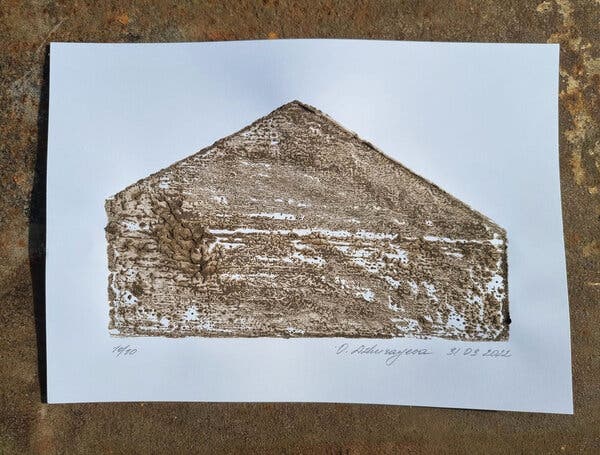
A print of a basic house with a pointed roof, with the pigment on the paper made of dark brown soil and the artist’s name signed below. “The House Whose Lights Went Out Forever,” is another in Olesya Dzhurayeva’s 2022 series of woodcuts that is represented in the Lunar Codex. Credit…via Olesya Dzhurayeva and Mesh GalleryInsert your content here
The moon has hosted earthly art for decades. “The Moon Museum,” a tiny ceramic tile featuring line drawings by Forrest Myers, Andy Warhol, Claes Oldenburg, Robert Rauschenberg, David Novros and John Chamberlain, was discreetly attached to the leg of a lunar module left on the moon as part of the Apollo 12 mission in 1969. “Fallen Astronaut,” an aluminum sculpture by the Belgian artist Paul van Hoeydonck, was left on the lunar surface by the Apollo 15 crew in 1971, with a plaque commemorating 14 American astronauts and Soviet cosmonauts who died in scientific service to their countries.
Outside of the Lunar Codex project, other contemporary artists are aiming to place solo works on the moon’s surface through commercial space travel, including Jeff Koons and the British artist Sacha Jafri. The Arch Mission Foundation has sent Isaac Asimov’s “Foundation” trilogy and millions of Lunar Library pages into space.
But the Lunar Codex has bigger storytelling ambitions. It’s divided into four time capsules, with its material copied onto digital memory cards or inscribed into nickel-based NanoFiche, a lightweight analog storage media that can hold 150,000 laser-etched microscopic pages of text or photos on one 8.5-by-11-inch sheet. The concept is “like the Golden Record,” Peralta said, referring to NASA’s own cultural time capsule of audio and images stored on a metal disc and sent into space aboard the Voyager probes in 1977. “Gold would be incredibly heavy. Nickel wafers are much, much lighter.”
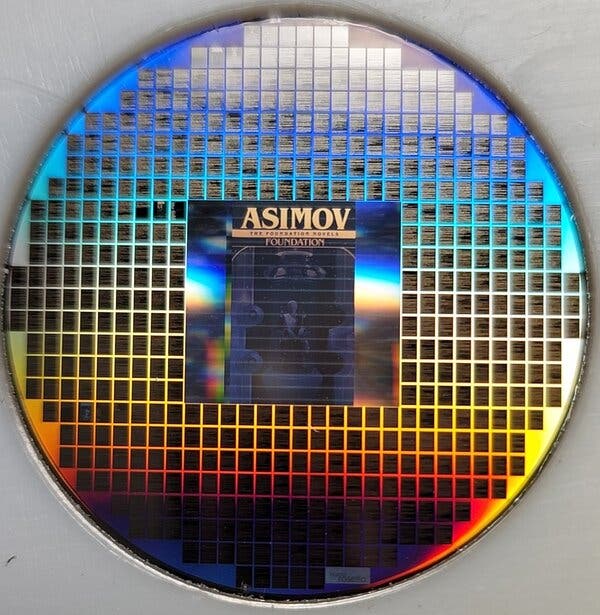
A sample of nickel-based NanoFiche disc, about the size of a U.S. quarter, storing microscopic pages of Isaac Asimov’s “Foundation.” This storage media can withstand electromagnetic radiation, high heat, extreme cold and other elements. Credit…Lunar Codex
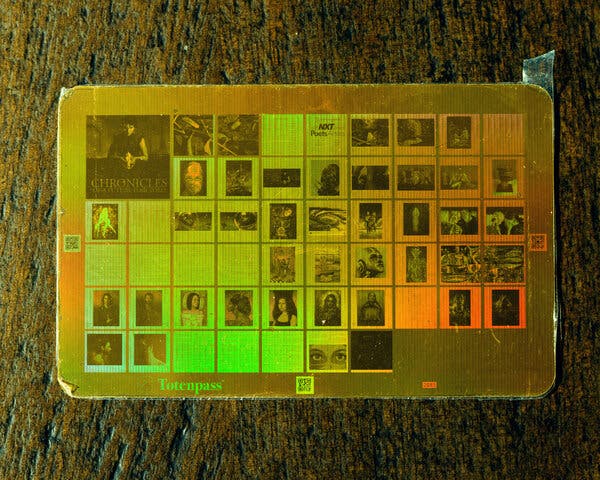
Exhibition catalogs full of artwork have been miniaturized and etched onto NanoFiche for the trip to the moon. Credit…Brendan George Ko for The New York Times
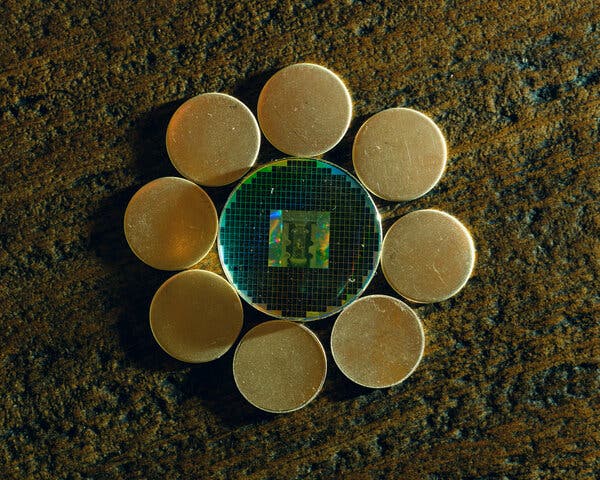
“Foundation” on a NanoFiche disc, surrounded by several blank discs. The contents of Lunar Codex are being stored on NanoFiche or digital memory cards. Credit…Brendan George Ko for The New York TimesInsert your content here
Ada Limón, the current U.S. poet laureate, wrote a poem for NASA’s Europa Clipper spacecraft bound for Jupiter next year. She also has poetry in the Lunar Codex, which holds about 25 years’ worth of “The Poet and the Poem,” a poetry radio show/podcast founded and hosted by Grace Cavalieri — including episodes featuring Rita Dove, Louise Glück and other U.S. poet laureates. Cavalieri, a prolific poet herself, observed that sending art and poetry into space shows off civilization in a very human way. “We have the land deals, we have the treaties, but the only way we knew how people really felt, and their sensibilities, is in the poetry from the beginning of time,” she said.
Didi Menéndez, the publisher, curator and editor of PoetsArtists, has been sending digitized issues and other publications to Peralta for inclusion in the Lunar Codex. “Many of the artists work in the contemporary figurative,” she said of the moon-bound collection. “We’re talking about things that are happening in politics and socially. It’s a view of the Earth and what’s happening now from an artist’s perspective. And what’s really happening with emotions.”
Steven Alan Bennett and his wife, Elaine Melotti Schmidt, the founders of The Bennett Prize, are also supporters of the Lunar Codex and have contributed catalogs featuring the past winners and finalists. “It’s not just STEM, it’s STEAM,” Bennett said, adding “arts” to the “science, technology, engineering and math” acronym.
“For Apollo, they were all male artists,” Menéndez said, noting the moon art previously delivered by NASA crews. “These payloads Sam is putting together have a very diverse group.”
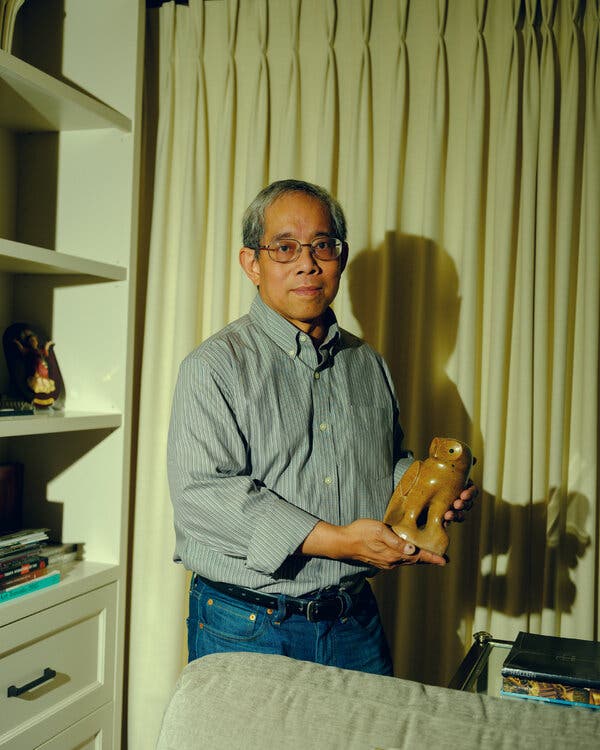
Samuel Peralta, the creator of the Lunar Codex, holds a soapstone Inuit sculpture at his home in Mississauga, Ontario. Credit…Brendan George Ko for The New York Times
Peralta, a polymath who got his Ph.D. in physics from the University of Wales, is the son of the Filipino anthropologist/playwright Jesus T. Peralta and the abstract artist Rosario Bitanga-Peralta. He started the Lunar Codex during the coronavirus pandemic to send his own work, including his science fiction books, to the moon before deciding to expand the scope.
He’s been compiling content for a few years, although some people he’s contacted haven’t taken him seriously. “I say, ‘I’d like to put your art on the moon,’ and they think this is some sort of a scam,” he said. His basic requirement for acceptance is that the artist or writer has been pre-curated by having work included in an exhibition, catalog or anthology.
One Codex capsule has already orbited the moon on NASA’s Orion mission last year. The Codex’s other capsules are scheduled to land and stay on the moon starting this fall through NASA’S Commercial Lunar Payload Services program, which awards contracts to aerospace engineering companies like Astrobotic Technology of Pittsburgh and Intuitive Machines of Houston. After the companies create the lander modules for NASA’s equipment, they can sell any extra room on board. Prices vary; Astrobotic charges $3,270 to ferry a 0.5-inch-by-1-inch “moon capsule” onboard one of its lunar landers.
Peralta is largely funding the cost of the payload space on the three landers and doesn’t have a final price yet, but he said it’s been a fraction of the cost of buying a “space tourist” ticket on a commercial rocket. (A Virgin Galactic trip costs $450,000.)
Peralta sees the Lunar Codex as “a message in the bottle for the future that during this time of war, pandemic and economic upheaval people still found time to create beauty.” And, for those who want to follow its travels, the Codex’s current launch schedule and contents of each collection can be viewed at lunarcodex.com.
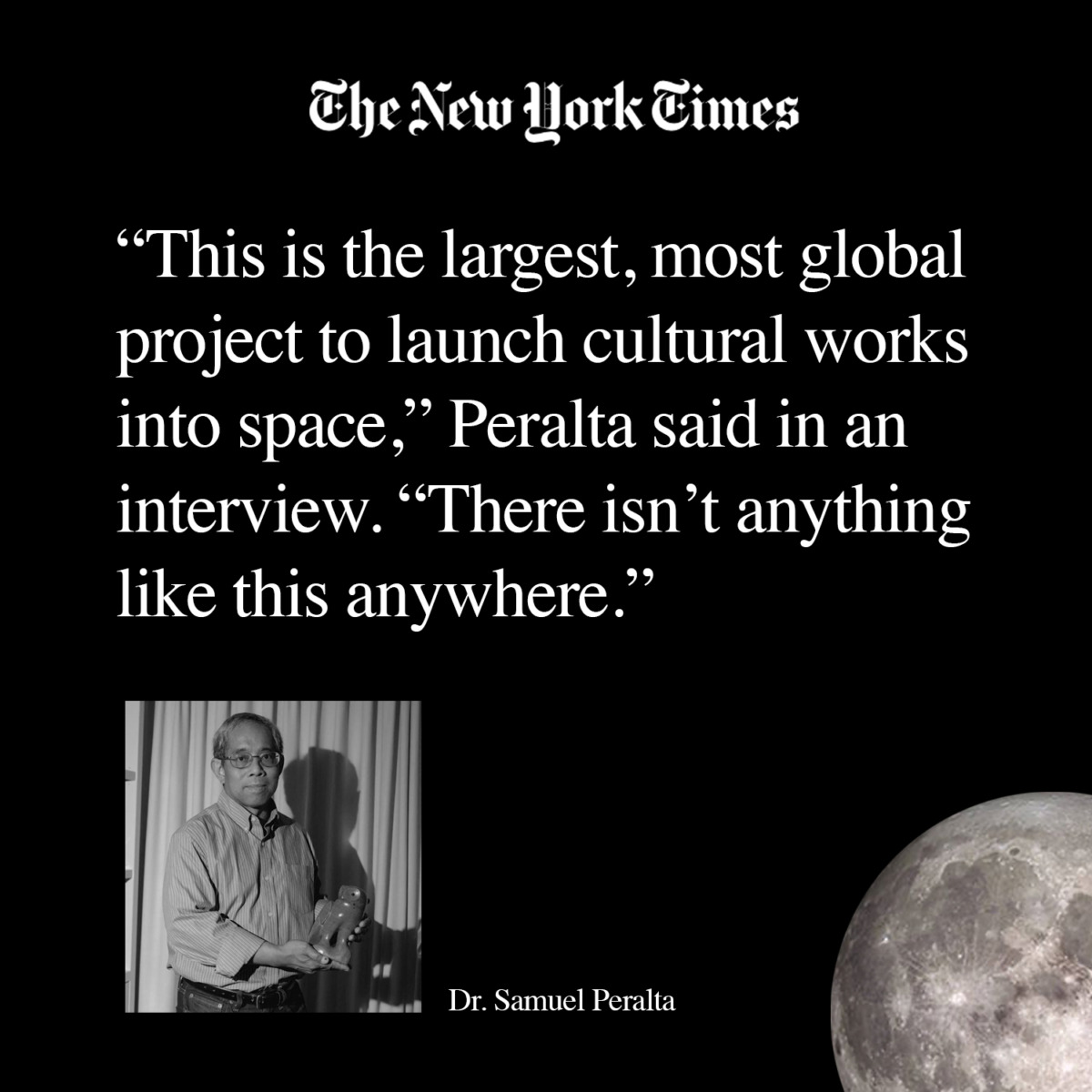
To explore a sample of some of the remarkable pieces included in the Lunar Codex project, simply click the links below.
J.D. Biersdorfer has been writing about consumer technology for The Times since 1998. She also creates the weekly interactive literary quiz for the Book Review and occasionally contributes reviews.More about J. D. Biersdorfer
A version of this article appears in print on July 28, 2023, Section C, Page 12 of the New York edition with the headline: Launching a Time Capsule of Human Creativity. https://www.nytimes.com/2023/07/27/arts/design/lunar-codex-time-capsule-moon.html





